Effective Interventions for Childhood Obesity: A Review
VerifiedAdded on 2023/03/20
|38
|7007
|45
Report
AI Summary
This report is a systematic review of interventions aimed at preventing childhood obesity among school-aged children, with a particular focus on the Australian context. The review examines the increasing prevalence of childhood obesity, highlighting its impact on health outcomes and the need for effective interventions. The methodology includes a detailed search strategy using databases like PubMed and CINAHL, along with the application of inclusion and exclusion criteria to select relevant studies. The methodological quality of the included studies was assessed using the AMSTAR tool. The results highlight the effectiveness of various interventions, such as school-based programs that incorporate healthy eating habits and increased physical activity. The report concludes by emphasizing the importance of evidence-based interventions in addressing childhood obesity and provides implications for future research and healthcare practices. The report also includes a comprehensive executive summary, table of contents, and appendices with relevant data extraction tables and flowcharts.
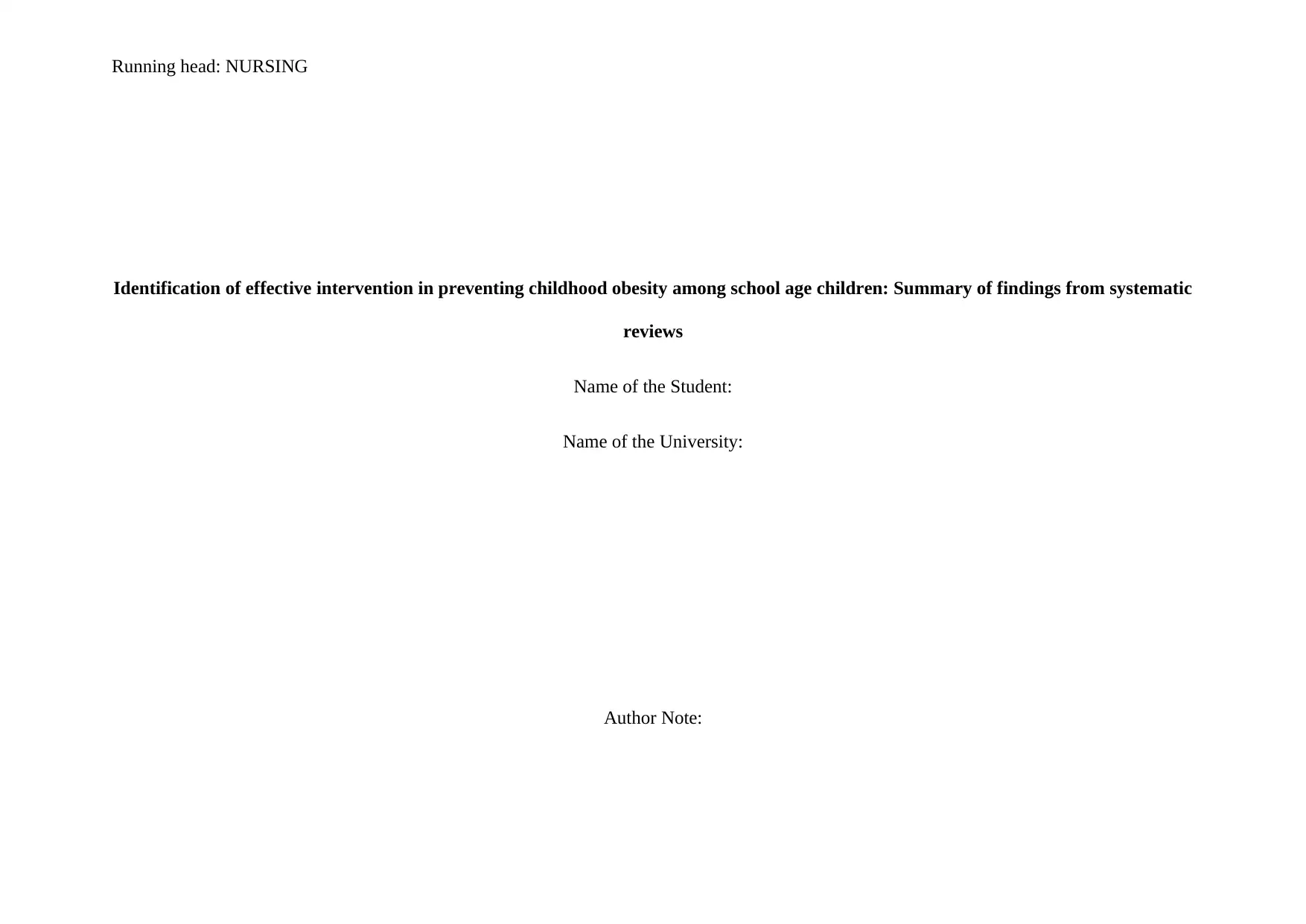
Running head: NURSING
Identification of effective intervention in preventing childhood obesity among school age children: Summary of findings from systematic
reviews
Name of the Student:
Name of the University:
Author Note:
Identification of effective intervention in preventing childhood obesity among school age children: Summary of findings from systematic
reviews
Name of the Student:
Name of the University:
Author Note:
Paraphrase This Document
Need a fresh take? Get an instant paraphrase of this document with our AI Paraphraser
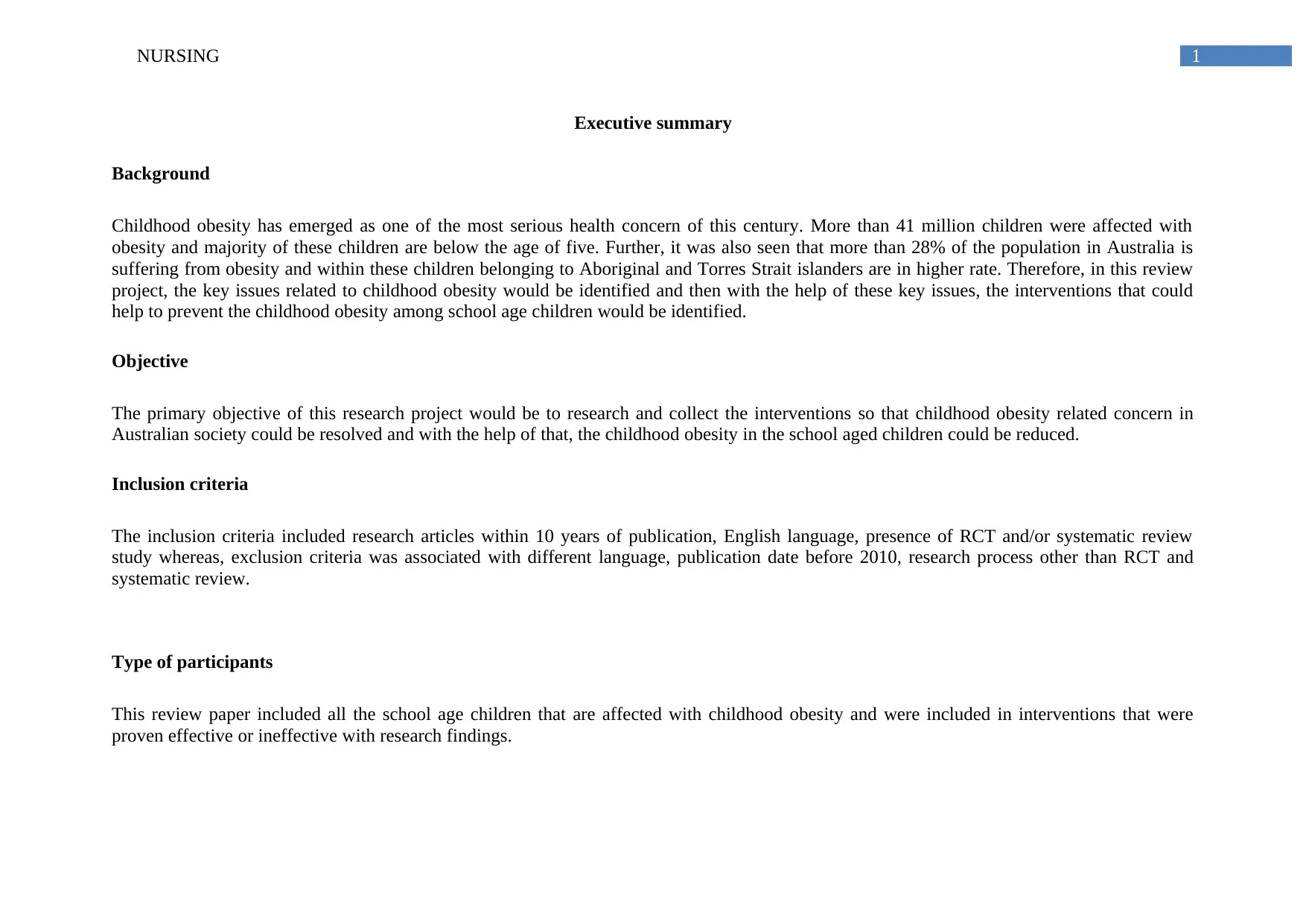
1NURSING
Executive summary
Background
Childhood obesity has emerged as one of the most serious health concern of this century. More than 41 million children were affected with
obesity and majority of these children are below the age of five. Further, it was also seen that more than 28% of the population in Australia is
suffering from obesity and within these children belonging to Aboriginal and Torres Strait islanders are in higher rate. Therefore, in this review
project, the key issues related to childhood obesity would be identified and then with the help of these key issues, the interventions that could
help to prevent the childhood obesity among school age children would be identified.
Objective
The primary objective of this research project would be to research and collect the interventions so that childhood obesity related concern in
Australian society could be resolved and with the help of that, the childhood obesity in the school aged children could be reduced.
Inclusion criteria
The inclusion criteria included research articles within 10 years of publication, English language, presence of RCT and/or systematic review
study whereas, exclusion criteria was associated with different language, publication date before 2010, research process other than RCT and
systematic review.
Type of participants
This review paper included all the school age children that are affected with childhood obesity and were included in interventions that were
proven effective or ineffective with research findings.
Executive summary
Background
Childhood obesity has emerged as one of the most serious health concern of this century. More than 41 million children were affected with
obesity and majority of these children are below the age of five. Further, it was also seen that more than 28% of the population in Australia is
suffering from obesity and within these children belonging to Aboriginal and Torres Strait islanders are in higher rate. Therefore, in this review
project, the key issues related to childhood obesity would be identified and then with the help of these key issues, the interventions that could
help to prevent the childhood obesity among school age children would be identified.
Objective
The primary objective of this research project would be to research and collect the interventions so that childhood obesity related concern in
Australian society could be resolved and with the help of that, the childhood obesity in the school aged children could be reduced.
Inclusion criteria
The inclusion criteria included research articles within 10 years of publication, English language, presence of RCT and/or systematic review
study whereas, exclusion criteria was associated with different language, publication date before 2010, research process other than RCT and
systematic review.
Type of participants
This review paper included all the school age children that are affected with childhood obesity and were included in interventions that were
proven effective or ineffective with research findings.
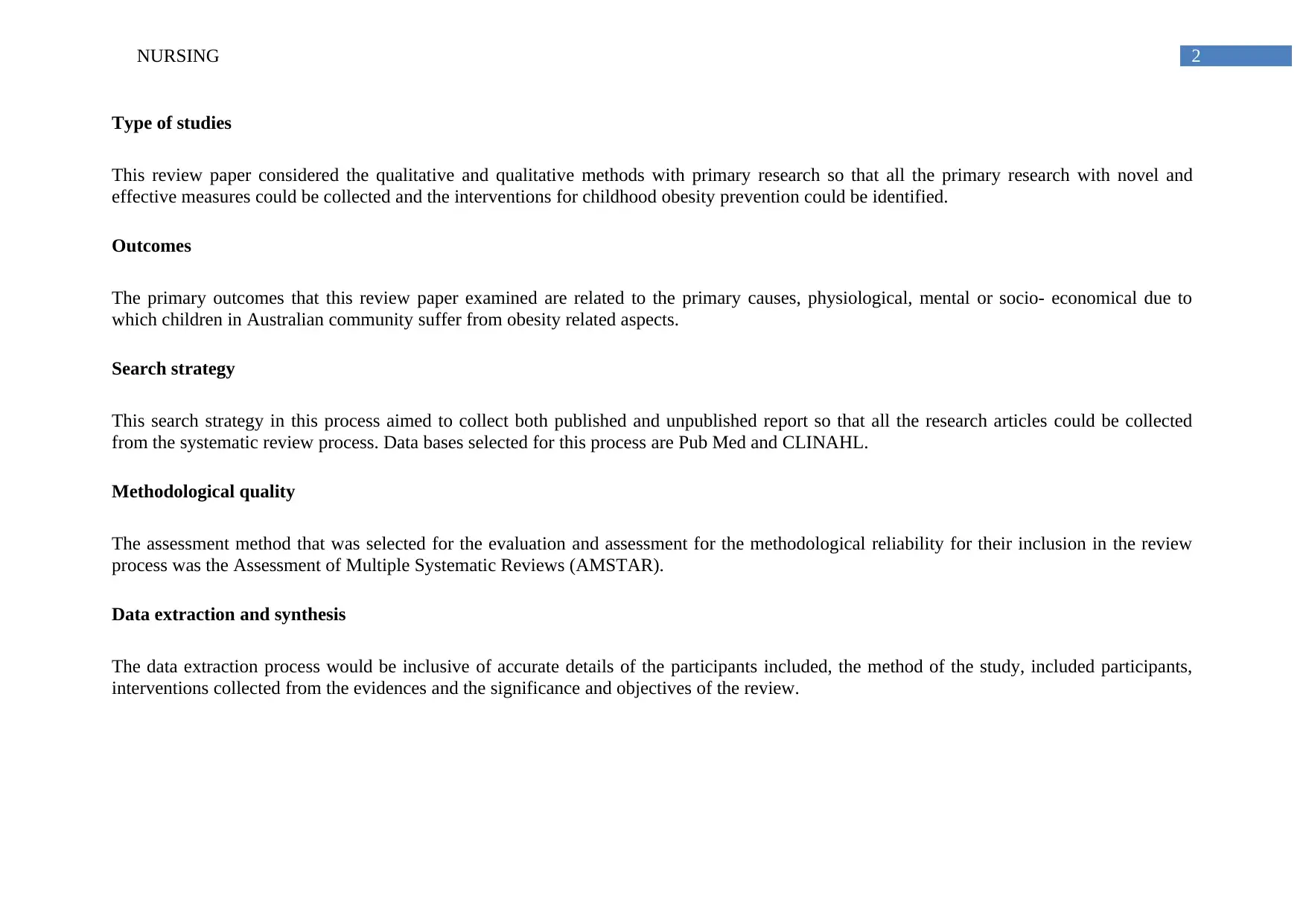
2NURSING
Type of studies
This review paper considered the qualitative and qualitative methods with primary research so that all the primary research with novel and
effective measures could be collected and the interventions for childhood obesity prevention could be identified.
Outcomes
The primary outcomes that this review paper examined are related to the primary causes, physiological, mental or socio- economical due to
which children in Australian community suffer from obesity related aspects.
Search strategy
This search strategy in this process aimed to collect both published and unpublished report so that all the research articles could be collected
from the systematic review process. Data bases selected for this process are Pub Med and CLINAHL.
Methodological quality
The assessment method that was selected for the evaluation and assessment for the methodological reliability for their inclusion in the review
process was the Assessment of Multiple Systematic Reviews (AMSTAR).
Data extraction and synthesis
The data extraction process would be inclusive of accurate details of the participants included, the method of the study, included participants,
interventions collected from the evidences and the significance and objectives of the review.
Type of studies
This review paper considered the qualitative and qualitative methods with primary research so that all the primary research with novel and
effective measures could be collected and the interventions for childhood obesity prevention could be identified.
Outcomes
The primary outcomes that this review paper examined are related to the primary causes, physiological, mental or socio- economical due to
which children in Australian community suffer from obesity related aspects.
Search strategy
This search strategy in this process aimed to collect both published and unpublished report so that all the research articles could be collected
from the systematic review process. Data bases selected for this process are Pub Med and CLINAHL.
Methodological quality
The assessment method that was selected for the evaluation and assessment for the methodological reliability for their inclusion in the review
process was the Assessment of Multiple Systematic Reviews (AMSTAR).
Data extraction and synthesis
The data extraction process would be inclusive of accurate details of the participants included, the method of the study, included participants,
interventions collected from the evidences and the significance and objectives of the review.
⊘ This is a preview!⊘
Do you want full access?
Subscribe today to unlock all pages.

Trusted by 1+ million students worldwide
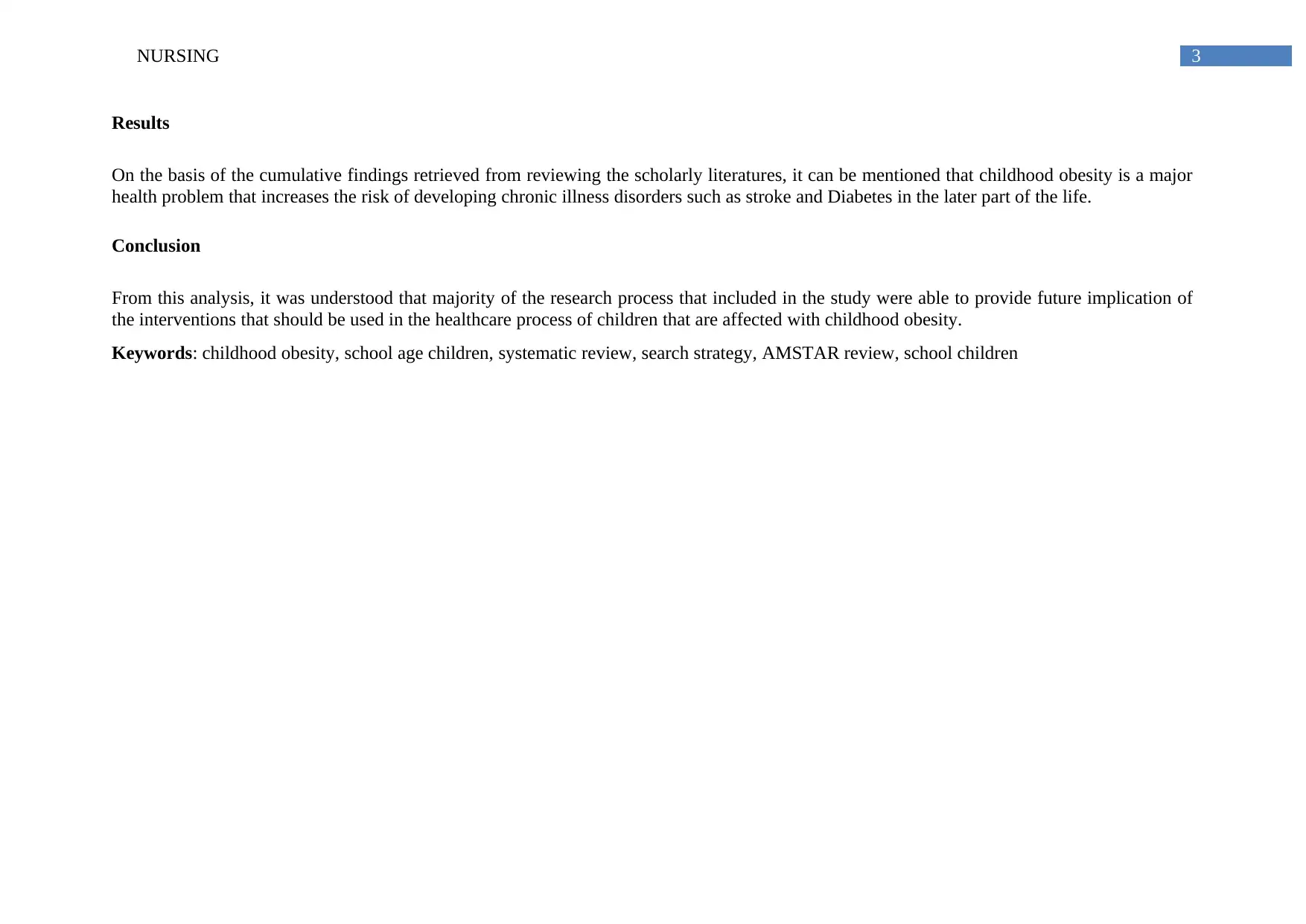
3NURSING
Results
On the basis of the cumulative findings retrieved from reviewing the scholarly literatures, it can be mentioned that childhood obesity is a major
health problem that increases the risk of developing chronic illness disorders such as stroke and Diabetes in the later part of the life.
Conclusion
From this analysis, it was understood that majority of the research process that included in the study were able to provide future implication of
the interventions that should be used in the healthcare process of children that are affected with childhood obesity.
Keywords: childhood obesity, school age children, systematic review, search strategy, AMSTAR review, school children
Results
On the basis of the cumulative findings retrieved from reviewing the scholarly literatures, it can be mentioned that childhood obesity is a major
health problem that increases the risk of developing chronic illness disorders such as stroke and Diabetes in the later part of the life.
Conclusion
From this analysis, it was understood that majority of the research process that included in the study were able to provide future implication of
the interventions that should be used in the healthcare process of children that are affected with childhood obesity.
Keywords: childhood obesity, school age children, systematic review, search strategy, AMSTAR review, school children
Paraphrase This Document
Need a fresh take? Get an instant paraphrase of this document with our AI Paraphraser
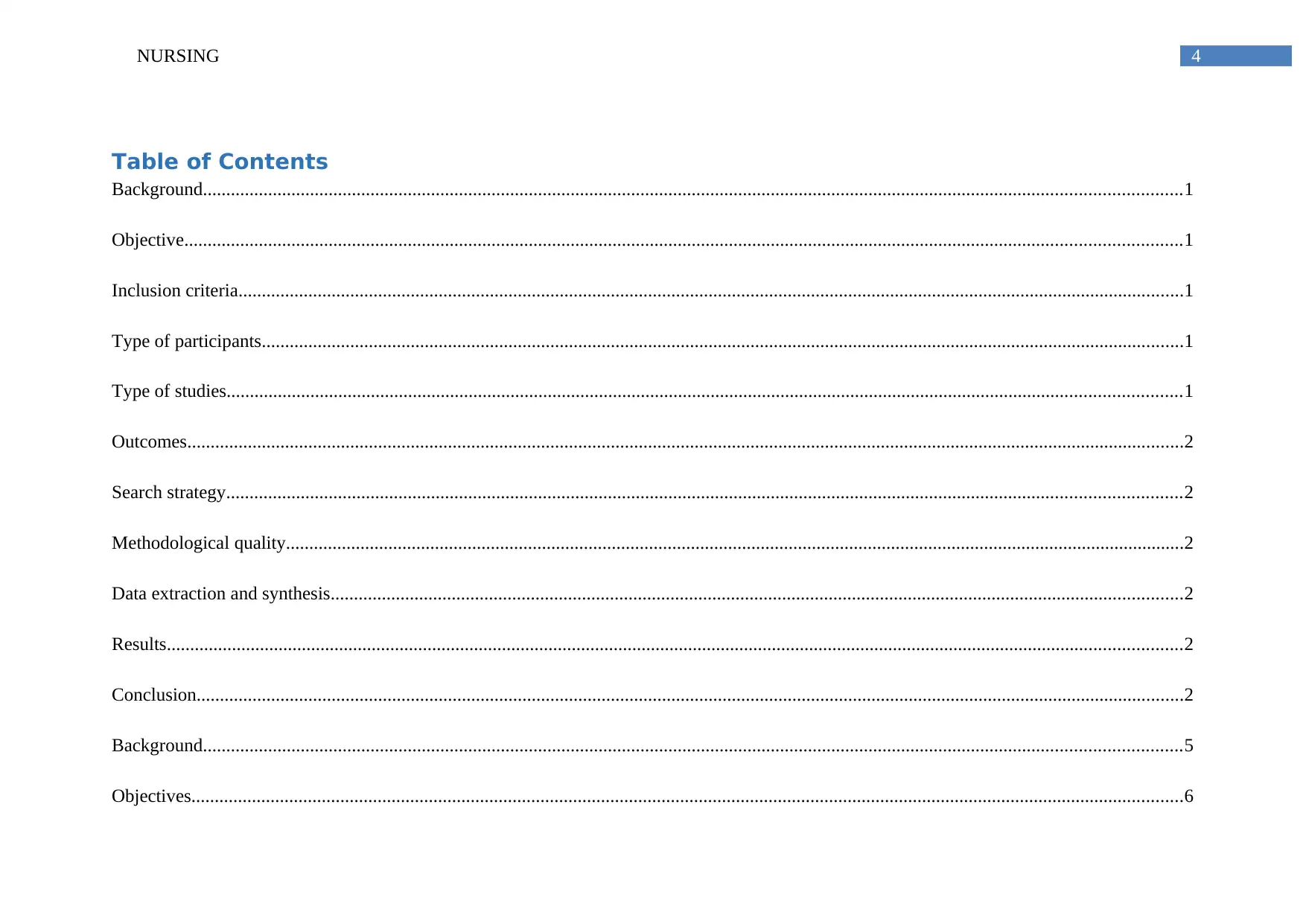
4NURSING
Table of Contents
Background..................................................................................................................................................................................................................1
Objective......................................................................................................................................................................................................................1
Inclusion criteria...........................................................................................................................................................................................................1
Type of participants......................................................................................................................................................................................................1
Type of studies.............................................................................................................................................................................................................1
Outcomes......................................................................................................................................................................................................................2
Search strategy.............................................................................................................................................................................................................2
Methodological quality.................................................................................................................................................................................................2
Data extraction and synthesis.......................................................................................................................................................................................2
Results..........................................................................................................................................................................................................................2
Conclusion....................................................................................................................................................................................................................2
Background..................................................................................................................................................................................................................5
Objectives.....................................................................................................................................................................................................................6
Table of Contents
Background..................................................................................................................................................................................................................1
Objective......................................................................................................................................................................................................................1
Inclusion criteria...........................................................................................................................................................................................................1
Type of participants......................................................................................................................................................................................................1
Type of studies.............................................................................................................................................................................................................1
Outcomes......................................................................................................................................................................................................................2
Search strategy.............................................................................................................................................................................................................2
Methodological quality.................................................................................................................................................................................................2
Data extraction and synthesis.......................................................................................................................................................................................2
Results..........................................................................................................................................................................................................................2
Conclusion....................................................................................................................................................................................................................2
Background..................................................................................................................................................................................................................5
Objectives.....................................................................................................................................................................................................................6
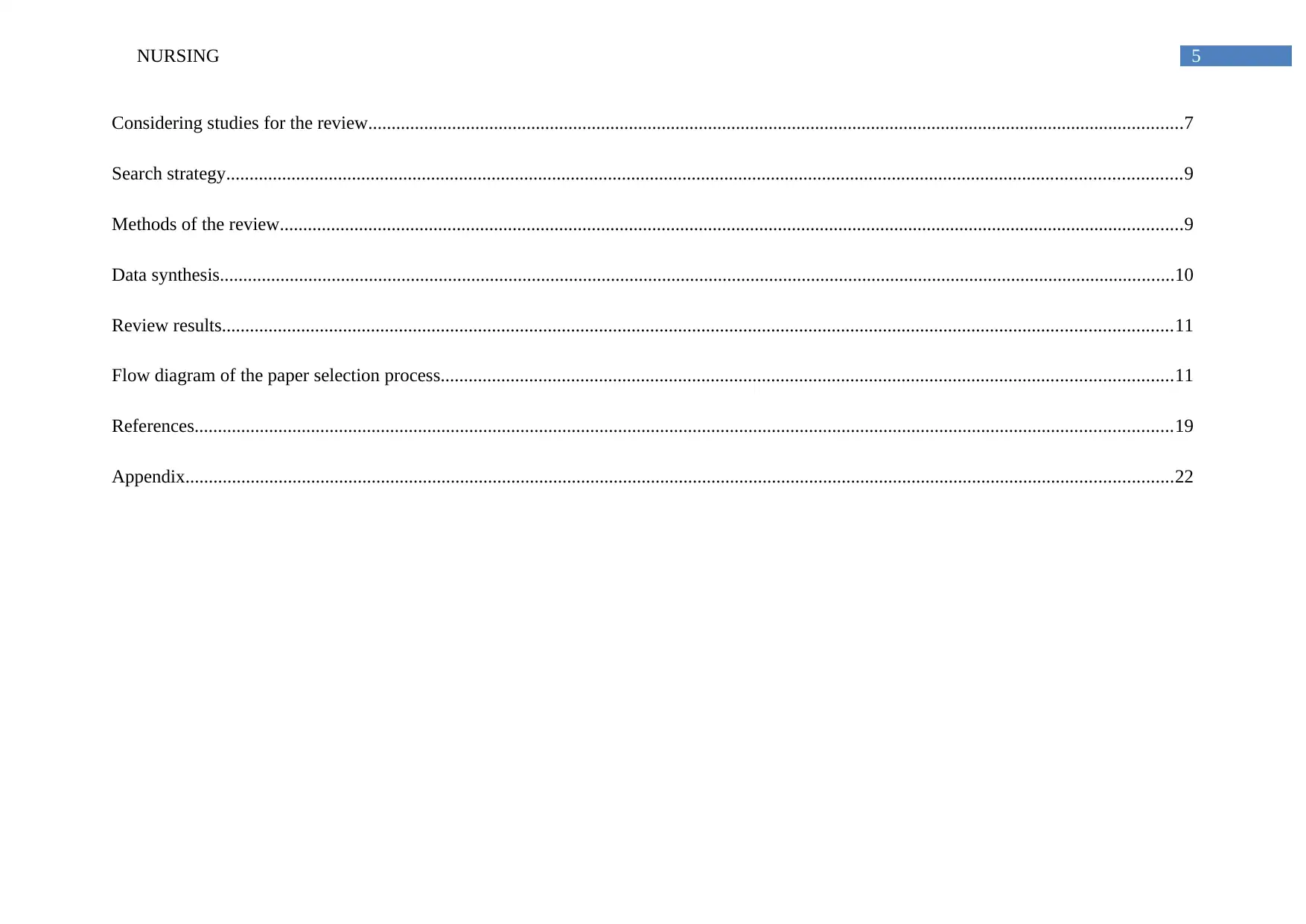
5NURSING
Considering studies for the review...............................................................................................................................................................................7
Search strategy.............................................................................................................................................................................................................9
Methods of the review..................................................................................................................................................................................................9
Data synthesis.............................................................................................................................................................................................................10
Review results............................................................................................................................................................................................................11
Flow diagram of the paper selection process.............................................................................................................................................................11
References..................................................................................................................................................................................................................19
Appendix....................................................................................................................................................................................................................22
Considering studies for the review...............................................................................................................................................................................7
Search strategy.............................................................................................................................................................................................................9
Methods of the review..................................................................................................................................................................................................9
Data synthesis.............................................................................................................................................................................................................10
Review results............................................................................................................................................................................................................11
Flow diagram of the paper selection process.............................................................................................................................................................11
References..................................................................................................................................................................................................................19
Appendix....................................................................................................................................................................................................................22
⊘ This is a preview!⊘
Do you want full access?
Subscribe today to unlock all pages.

Trusted by 1+ million students worldwide
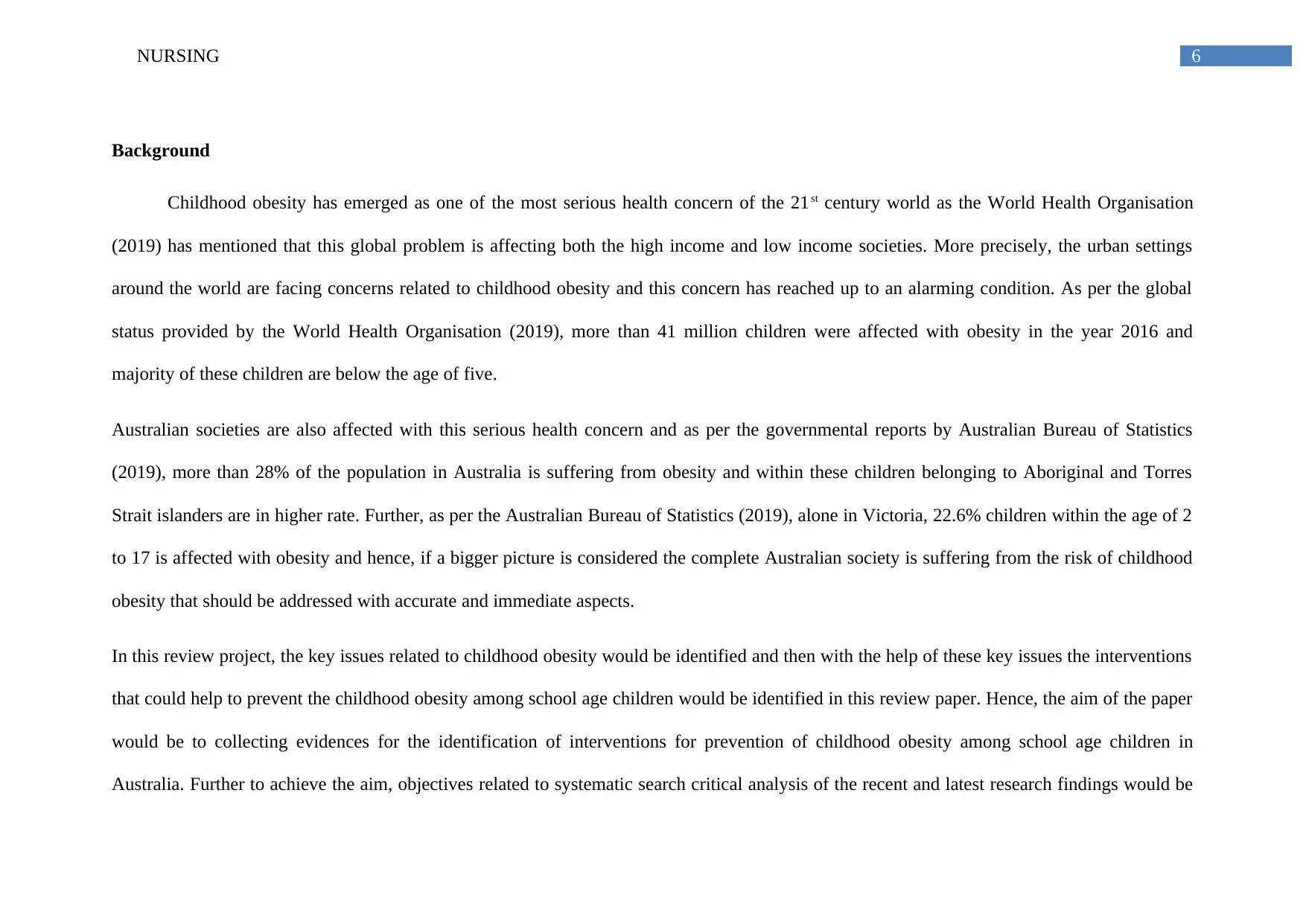
6NURSING
Background
Childhood obesity has emerged as one of the most serious health concern of the 21st century world as the World Health Organisation
(2019) has mentioned that this global problem is affecting both the high income and low income societies. More precisely, the urban settings
around the world are facing concerns related to childhood obesity and this concern has reached up to an alarming condition. As per the global
status provided by the World Health Organisation (2019), more than 41 million children were affected with obesity in the year 2016 and
majority of these children are below the age of five.
Australian societies are also affected with this serious health concern and as per the governmental reports by Australian Bureau of Statistics
(2019), more than 28% of the population in Australia is suffering from obesity and within these children belonging to Aboriginal and Torres
Strait islanders are in higher rate. Further, as per the Australian Bureau of Statistics (2019), alone in Victoria, 22.6% children within the age of 2
to 17 is affected with obesity and hence, if a bigger picture is considered the complete Australian society is suffering from the risk of childhood
obesity that should be addressed with accurate and immediate aspects.
In this review project, the key issues related to childhood obesity would be identified and then with the help of these key issues the interventions
that could help to prevent the childhood obesity among school age children would be identified in this review paper. Hence, the aim of the paper
would be to collecting evidences for the identification of interventions for prevention of childhood obesity among school age children in
Australia. Further to achieve the aim, objectives related to systematic search critical analysis of the recent and latest research findings would be
Background
Childhood obesity has emerged as one of the most serious health concern of the 21st century world as the World Health Organisation
(2019) has mentioned that this global problem is affecting both the high income and low income societies. More precisely, the urban settings
around the world are facing concerns related to childhood obesity and this concern has reached up to an alarming condition. As per the global
status provided by the World Health Organisation (2019), more than 41 million children were affected with obesity in the year 2016 and
majority of these children are below the age of five.
Australian societies are also affected with this serious health concern and as per the governmental reports by Australian Bureau of Statistics
(2019), more than 28% of the population in Australia is suffering from obesity and within these children belonging to Aboriginal and Torres
Strait islanders are in higher rate. Further, as per the Australian Bureau of Statistics (2019), alone in Victoria, 22.6% children within the age of 2
to 17 is affected with obesity and hence, if a bigger picture is considered the complete Australian society is suffering from the risk of childhood
obesity that should be addressed with accurate and immediate aspects.
In this review project, the key issues related to childhood obesity would be identified and then with the help of these key issues the interventions
that could help to prevent the childhood obesity among school age children would be identified in this review paper. Hence, the aim of the paper
would be to collecting evidences for the identification of interventions for prevention of childhood obesity among school age children in
Australia. Further to achieve the aim, objectives related to systematic search critical analysis of the recent and latest research findings would be
Paraphrase This Document
Need a fresh take? Get an instant paraphrase of this document with our AI Paraphraser
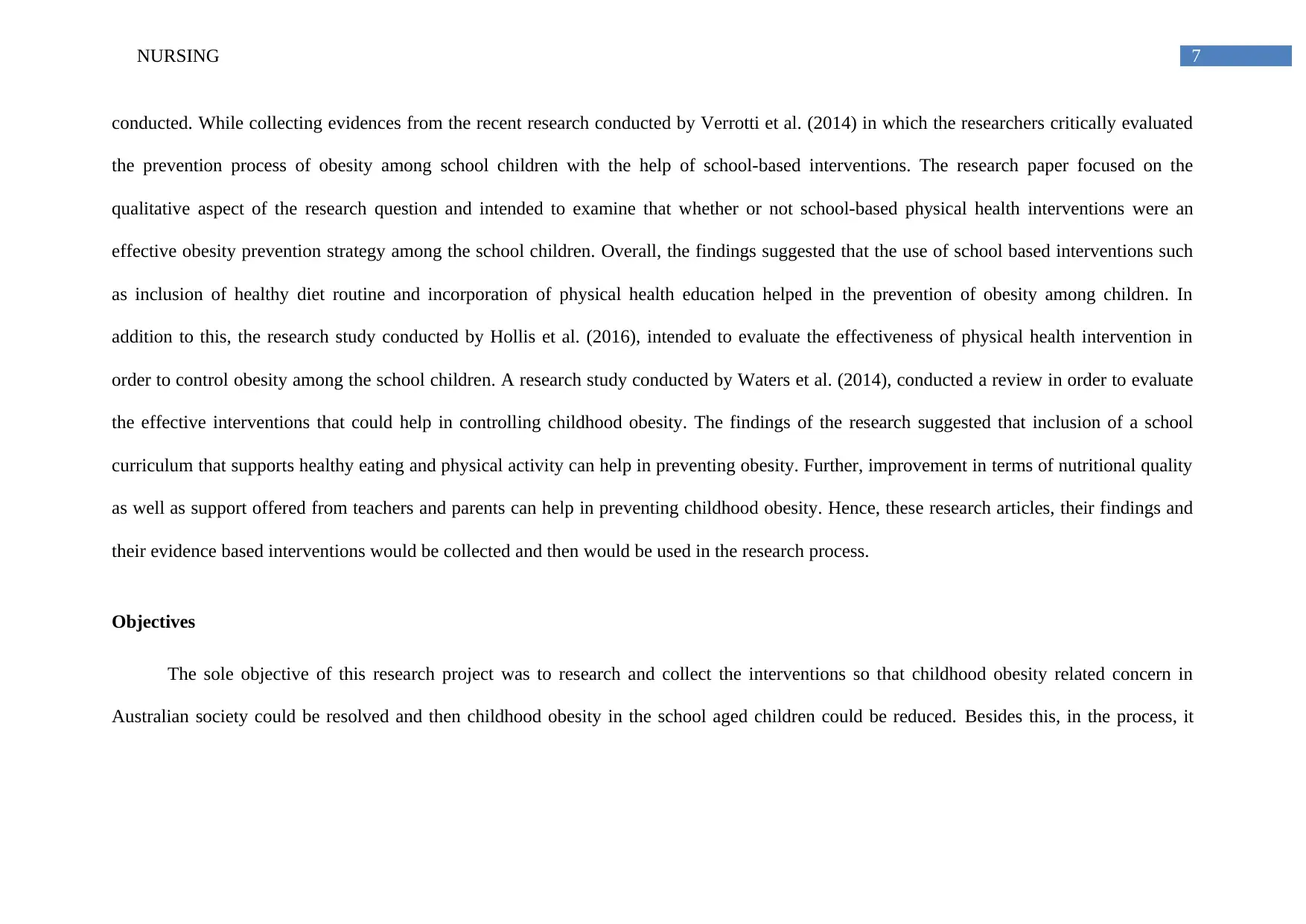
7NURSING
conducted. While collecting evidences from the recent research conducted by Verrotti et al. (2014) in which the researchers critically evaluated
the prevention process of obesity among school children with the help of school-based interventions. The research paper focused on the
qualitative aspect of the research question and intended to examine that whether or not school-based physical health interventions were an
effective obesity prevention strategy among the school children. Overall, the findings suggested that the use of school based interventions such
as inclusion of healthy diet routine and incorporation of physical health education helped in the prevention of obesity among children. In
addition to this, the research study conducted by Hollis et al. (2016), intended to evaluate the effectiveness of physical health intervention in
order to control obesity among the school children. A research study conducted by Waters et al. (2014), conducted a review in order to evaluate
the effective interventions that could help in controlling childhood obesity. The findings of the research suggested that inclusion of a school
curriculum that supports healthy eating and physical activity can help in preventing obesity. Further, improvement in terms of nutritional quality
as well as support offered from teachers and parents can help in preventing childhood obesity. Hence, these research articles, their findings and
their evidence based interventions would be collected and then would be used in the research process.
Objectives
The sole objective of this research project was to research and collect the interventions so that childhood obesity related concern in
Australian society could be resolved and then childhood obesity in the school aged children could be reduced. Besides this, in the process, it
conducted. While collecting evidences from the recent research conducted by Verrotti et al. (2014) in which the researchers critically evaluated
the prevention process of obesity among school children with the help of school-based interventions. The research paper focused on the
qualitative aspect of the research question and intended to examine that whether or not school-based physical health interventions were an
effective obesity prevention strategy among the school children. Overall, the findings suggested that the use of school based interventions such
as inclusion of healthy diet routine and incorporation of physical health education helped in the prevention of obesity among children. In
addition to this, the research study conducted by Hollis et al. (2016), intended to evaluate the effectiveness of physical health intervention in
order to control obesity among the school children. A research study conducted by Waters et al. (2014), conducted a review in order to evaluate
the effective interventions that could help in controlling childhood obesity. The findings of the research suggested that inclusion of a school
curriculum that supports healthy eating and physical activity can help in preventing obesity. Further, improvement in terms of nutritional quality
as well as support offered from teachers and parents can help in preventing childhood obesity. Hence, these research articles, their findings and
their evidence based interventions would be collected and then would be used in the research process.
Objectives
The sole objective of this research project was to research and collect the interventions so that childhood obesity related concern in
Australian society could be resolved and then childhood obesity in the school aged children could be reduced. Besides this, in the process, it
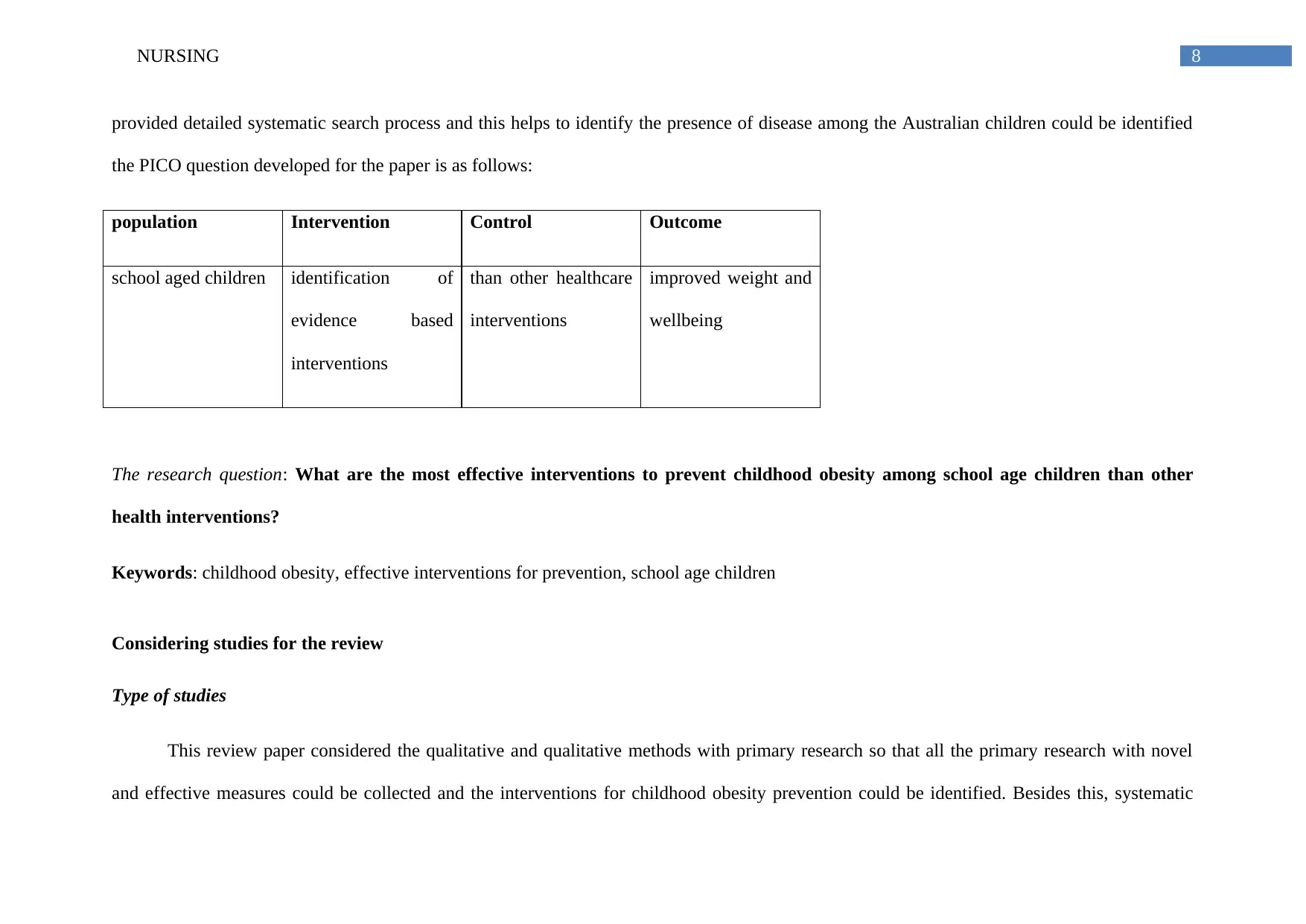
8NURSING
provided detailed systematic search process and this helps to identify the presence of disease among the Australian children could be identified
the PICO question developed for the paper is as follows:
population Intervention Control Outcome
school aged children identification of
evidence based
interventions
than other healthcare
interventions
improved weight and
wellbeing
The research question: What are the most effective interventions to prevent childhood obesity among school age children than other
health interventions?
Keywords: childhood obesity, effective interventions for prevention, school age children
Considering studies for the review
Type of studies
This review paper considered the qualitative and qualitative methods with primary research so that all the primary research with novel
and effective measures could be collected and the interventions for childhood obesity prevention could be identified. Besides this, systematic
provided detailed systematic search process and this helps to identify the presence of disease among the Australian children could be identified
the PICO question developed for the paper is as follows:
population Intervention Control Outcome
school aged children identification of
evidence based
interventions
than other healthcare
interventions
improved weight and
wellbeing
The research question: What are the most effective interventions to prevent childhood obesity among school age children than other
health interventions?
Keywords: childhood obesity, effective interventions for prevention, school age children
Considering studies for the review
Type of studies
This review paper considered the qualitative and qualitative methods with primary research so that all the primary research with novel
and effective measures could be collected and the interventions for childhood obesity prevention could be identified. Besides this, systematic
⊘ This is a preview!⊘
Do you want full access?
Subscribe today to unlock all pages.

Trusted by 1+ million students worldwide
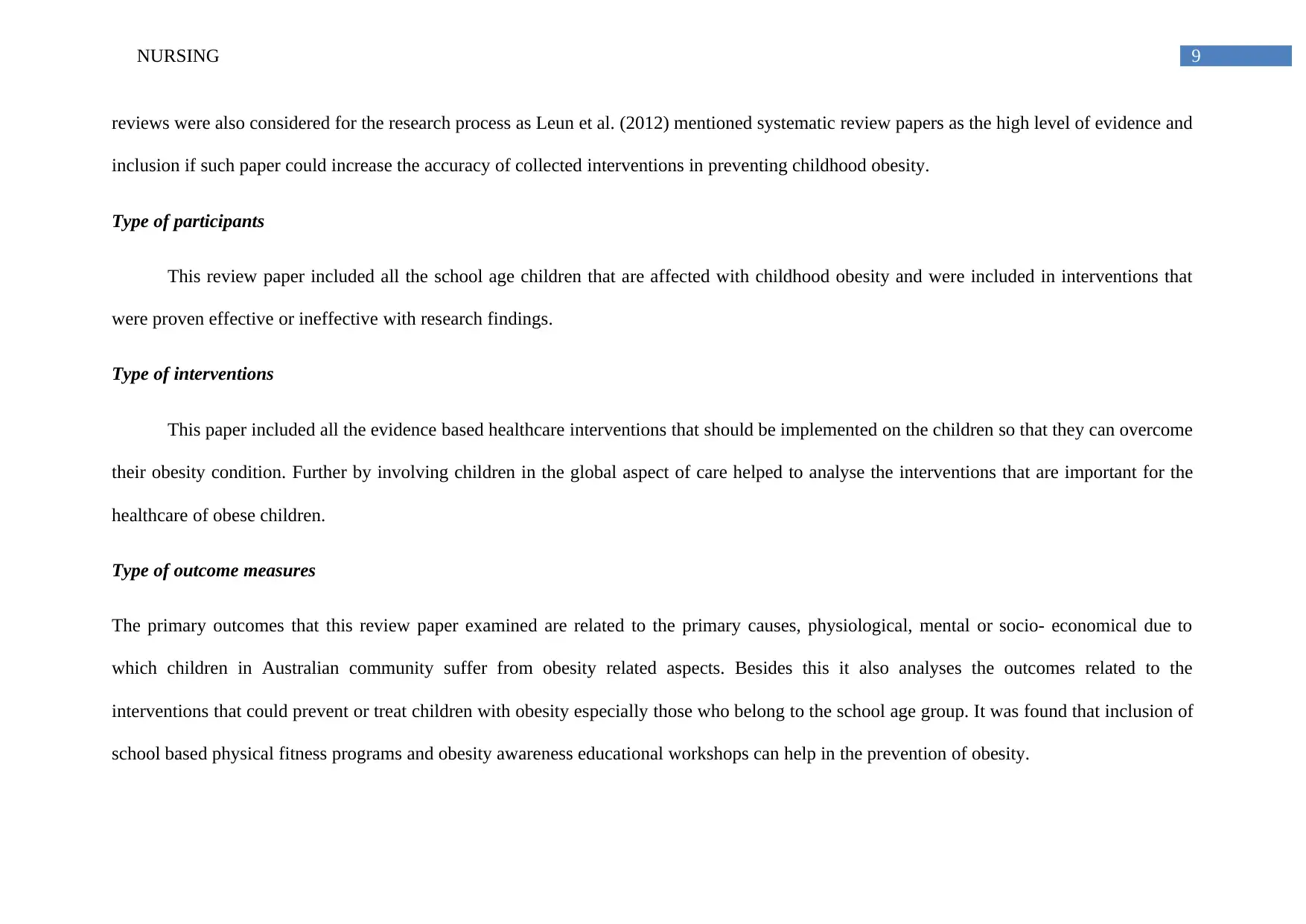
9NURSING
reviews were also considered for the research process as Leun et al. (2012) mentioned systematic review papers as the high level of evidence and
inclusion if such paper could increase the accuracy of collected interventions in preventing childhood obesity.
Type of participants
This review paper included all the school age children that are affected with childhood obesity and were included in interventions that
were proven effective or ineffective with research findings.
Type of interventions
This paper included all the evidence based healthcare interventions that should be implemented on the children so that they can overcome
their obesity condition. Further by involving children in the global aspect of care helped to analyse the interventions that are important for the
healthcare of obese children.
Type of outcome measures
The primary outcomes that this review paper examined are related to the primary causes, physiological, mental or socio- economical due to
which children in Australian community suffer from obesity related aspects. Besides this it also analyses the outcomes related to the
interventions that could prevent or treat children with obesity especially those who belong to the school age group. It was found that inclusion of
school based physical fitness programs and obesity awareness educational workshops can help in the prevention of obesity.
reviews were also considered for the research process as Leun et al. (2012) mentioned systematic review papers as the high level of evidence and
inclusion if such paper could increase the accuracy of collected interventions in preventing childhood obesity.
Type of participants
This review paper included all the school age children that are affected with childhood obesity and were included in interventions that
were proven effective or ineffective with research findings.
Type of interventions
This paper included all the evidence based healthcare interventions that should be implemented on the children so that they can overcome
their obesity condition. Further by involving children in the global aspect of care helped to analyse the interventions that are important for the
healthcare of obese children.
Type of outcome measures
The primary outcomes that this review paper examined are related to the primary causes, physiological, mental or socio- economical due to
which children in Australian community suffer from obesity related aspects. Besides this it also analyses the outcomes related to the
interventions that could prevent or treat children with obesity especially those who belong to the school age group. It was found that inclusion of
school based physical fitness programs and obesity awareness educational workshops can help in the prevention of obesity.
Paraphrase This Document
Need a fresh take? Get an instant paraphrase of this document with our AI Paraphraser
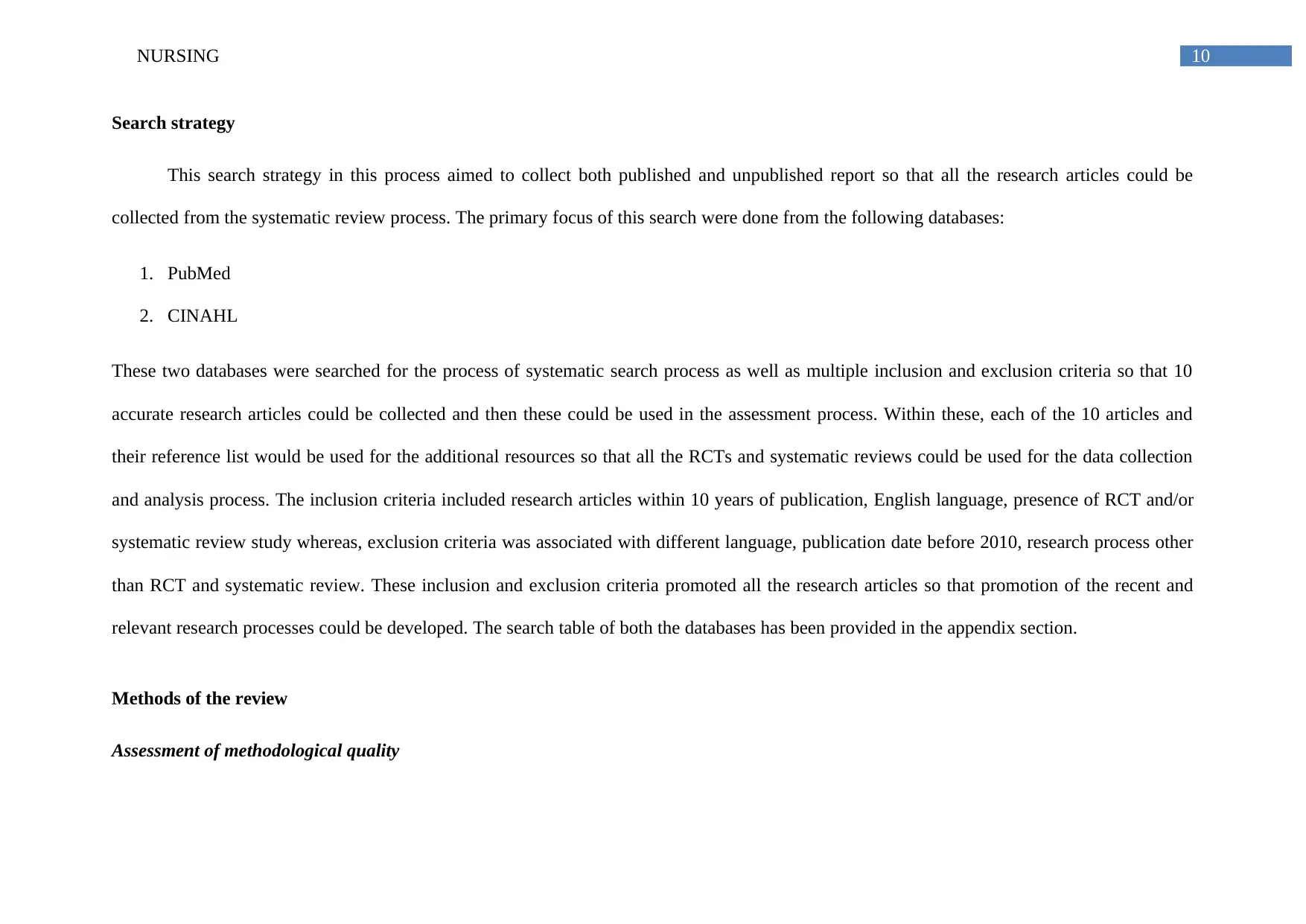
10NURSING
Search strategy
This search strategy in this process aimed to collect both published and unpublished report so that all the research articles could be
collected from the systematic review process. The primary focus of this search were done from the following databases:
1. PubMed
2. CINAHL
These two databases were searched for the process of systematic search process as well as multiple inclusion and exclusion criteria so that 10
accurate research articles could be collected and then these could be used in the assessment process. Within these, each of the 10 articles and
their reference list would be used for the additional resources so that all the RCTs and systematic reviews could be used for the data collection
and analysis process. The inclusion criteria included research articles within 10 years of publication, English language, presence of RCT and/or
systematic review study whereas, exclusion criteria was associated with different language, publication date before 2010, research process other
than RCT and systematic review. These inclusion and exclusion criteria promoted all the research articles so that promotion of the recent and
relevant research processes could be developed. The search table of both the databases has been provided in the appendix section.
Methods of the review
Assessment of methodological quality
Search strategy
This search strategy in this process aimed to collect both published and unpublished report so that all the research articles could be
collected from the systematic review process. The primary focus of this search were done from the following databases:
1. PubMed
2. CINAHL
These two databases were searched for the process of systematic search process as well as multiple inclusion and exclusion criteria so that 10
accurate research articles could be collected and then these could be used in the assessment process. Within these, each of the 10 articles and
their reference list would be used for the additional resources so that all the RCTs and systematic reviews could be used for the data collection
and analysis process. The inclusion criteria included research articles within 10 years of publication, English language, presence of RCT and/or
systematic review study whereas, exclusion criteria was associated with different language, publication date before 2010, research process other
than RCT and systematic review. These inclusion and exclusion criteria promoted all the research articles so that promotion of the recent and
relevant research processes could be developed. The search table of both the databases has been provided in the appendix section.
Methods of the review
Assessment of methodological quality
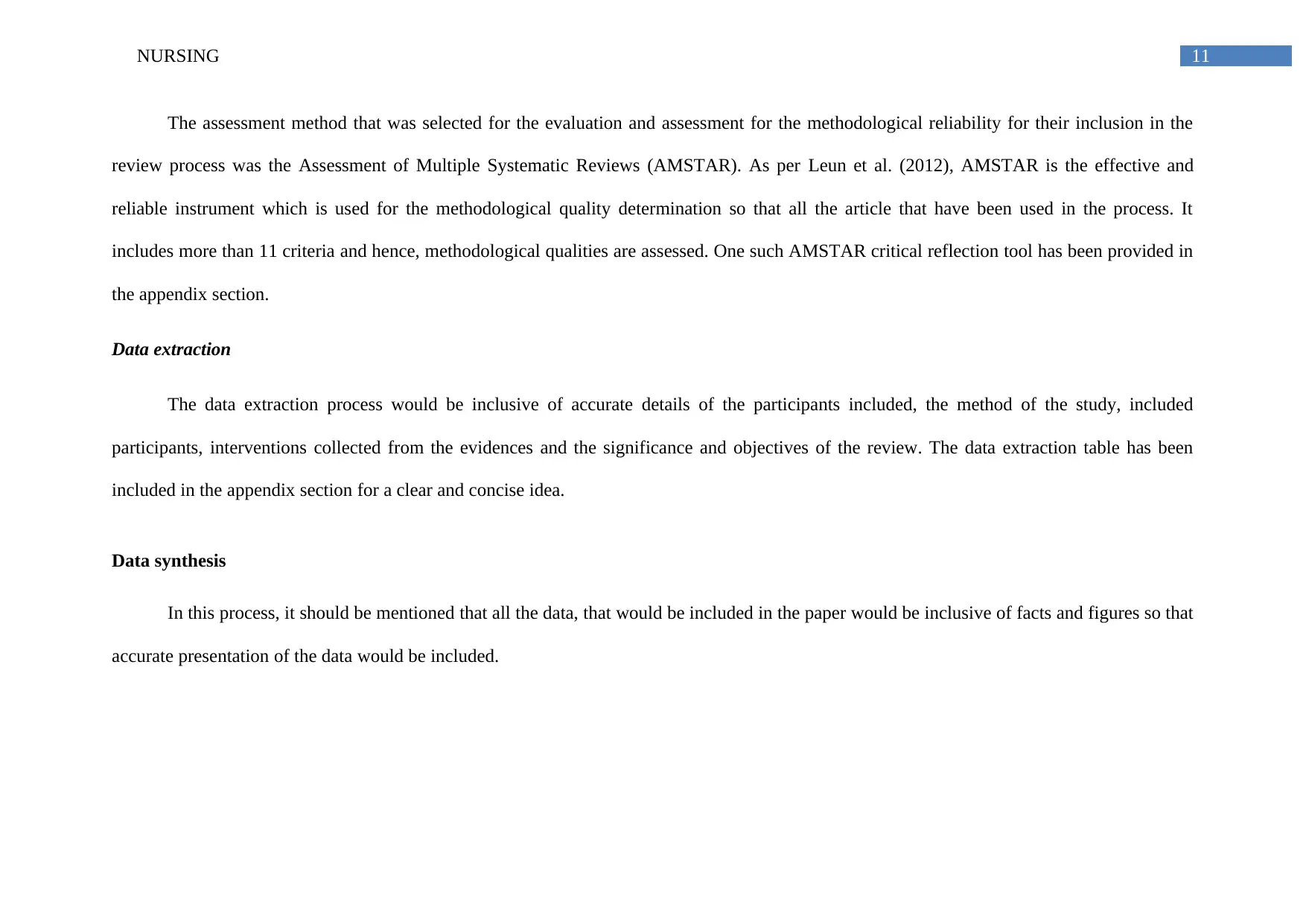
11NURSING
The assessment method that was selected for the evaluation and assessment for the methodological reliability for their inclusion in the
review process was the Assessment of Multiple Systematic Reviews (AMSTAR). As per Leun et al. (2012), AMSTAR is the effective and
reliable instrument which is used for the methodological quality determination so that all the article that have been used in the process. It
includes more than 11 criteria and hence, methodological qualities are assessed. One such AMSTAR critical reflection tool has been provided in
the appendix section.
Data extraction
The data extraction process would be inclusive of accurate details of the participants included, the method of the study, included
participants, interventions collected from the evidences and the significance and objectives of the review. The data extraction table has been
included in the appendix section for a clear and concise idea.
Data synthesis
In this process, it should be mentioned that all the data, that would be included in the paper would be inclusive of facts and figures so that
accurate presentation of the data would be included.
The assessment method that was selected for the evaluation and assessment for the methodological reliability for their inclusion in the
review process was the Assessment of Multiple Systematic Reviews (AMSTAR). As per Leun et al. (2012), AMSTAR is the effective and
reliable instrument which is used for the methodological quality determination so that all the article that have been used in the process. It
includes more than 11 criteria and hence, methodological qualities are assessed. One such AMSTAR critical reflection tool has been provided in
the appendix section.
Data extraction
The data extraction process would be inclusive of accurate details of the participants included, the method of the study, included
participants, interventions collected from the evidences and the significance and objectives of the review. The data extraction table has been
included in the appendix section for a clear and concise idea.
Data synthesis
In this process, it should be mentioned that all the data, that would be included in the paper would be inclusive of facts and figures so that
accurate presentation of the data would be included.
⊘ This is a preview!⊘
Do you want full access?
Subscribe today to unlock all pages.

Trusted by 1+ million students worldwide
1 out of 38
Related Documents
Your All-in-One AI-Powered Toolkit for Academic Success.
+13062052269
info@desklib.com
Available 24*7 on WhatsApp / Email
![[object Object]](/_next/static/media/star-bottom.7253800d.svg)
Unlock your academic potential
Copyright © 2020–2025 A2Z Services. All Rights Reserved. Developed and managed by ZUCOL.





